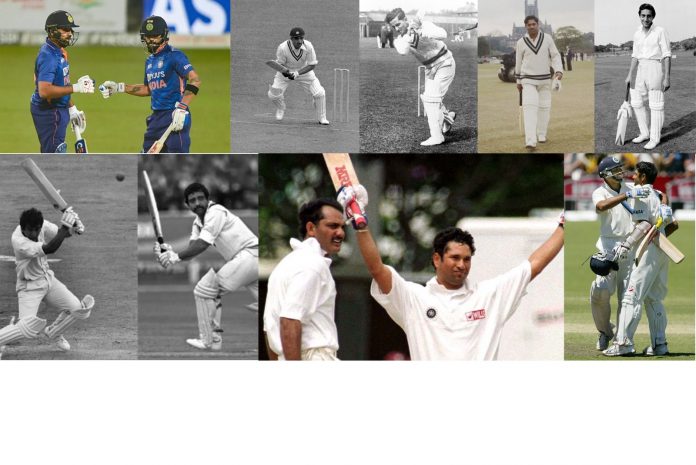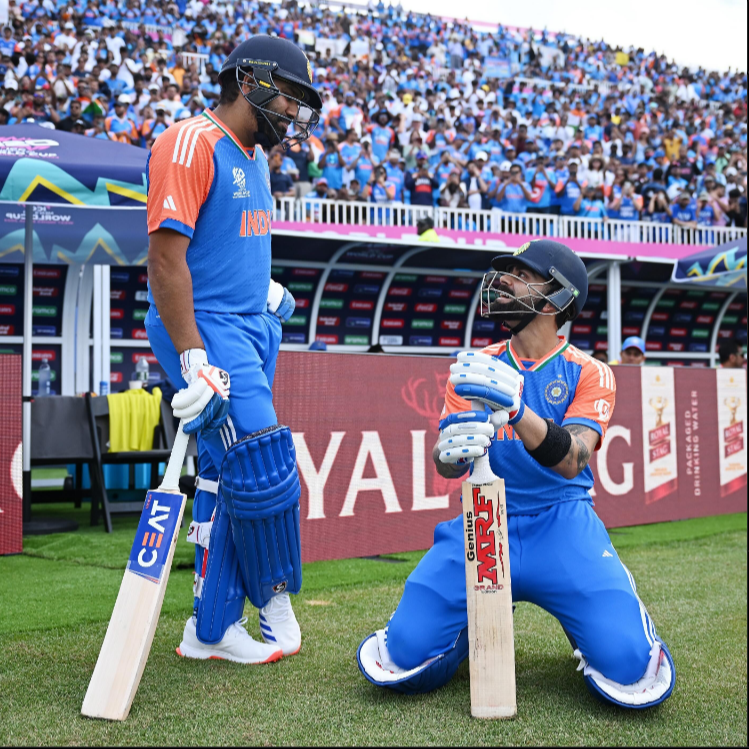
Rohit Sharma and Virat Kohli have been the flavour of the country with their pivotal contributions in India’s memorable T20 World Cup triumph.
Rohit set the tempo with this bionic batting as opener as well as superb captaincy, especially in how he handled his bowlers, getting the best out of them in pressure-cooker situations. In the final against South Africa, his captaincy. Effecting smart bowling changes and setting attacking fields in the taut final 5 overs, he turned the match around from a losing cause into a title-winning one.
Virat, who had had an undistinguished tournament till the final, showed why he is regarded as the best all-format batsman in contemporary cricket, making a vital 76 to help India make a score which the bowlers could defend. Losing three early wickets, India looked down for the count, but Virat steadied the ship with resolve and resourcefulness, his performance subscribing to the old cliché, ‘when the going gets tough, the tough get going’!
The fantastic exploits of Rohit and Virat over the years puts them alongside some stellar batting duos from India who played together.
Here are other pairs whose contribution to Indian cricket has been stellar.
Need a collage:

Vijay Merchant – cricmash.com

Vijay Hazare – cricmash.com
Vijay Merchant and Vijay Hazare were the two outstanding Indian batsmen at the time when India became independent. Though they didn’t play many matches together for India, they were the pillars on which India’s batting heft is structured.
Merchant was the epitome of technical virtuosity, and widely regarded as the founder of the Bombay School of batsmanship which merits a thesis. The `khadoos’ mindset of Bombay cricketers emerges from Merchant’s approach to the game: tough and uncompromising, putting a premium on his wicket at all times. Vijay Manjrekar, Polly Umrigar, Dilip Sardesai, Sunil Gavaskar, Dilip Vengsarkar, Sachin Tendulkar and Rohit Sharma are notable names who carried Merchant’s legacy forward.
Unlike Merchant, who came from a renowned business family which gave him the luxury of even having a personal coach in his formative years, Hazare, who played for Baroda, came from a more egalitarian background. Mild-mannered and soft-spoken, Hazare was sublime in his batting and lifestyle, but no less ambitious in chasing excellence. Hazare’s rivalry with Merchant in the Ranji Trophy is part of cricket folklore. But Hazare’s biggest renown comes from independent India’s first-ever Test series – against Don Bradman’s Invincibles – in which he scored a century in each innings of the Test at Adelaide.
Need a collage of the below 2 images:
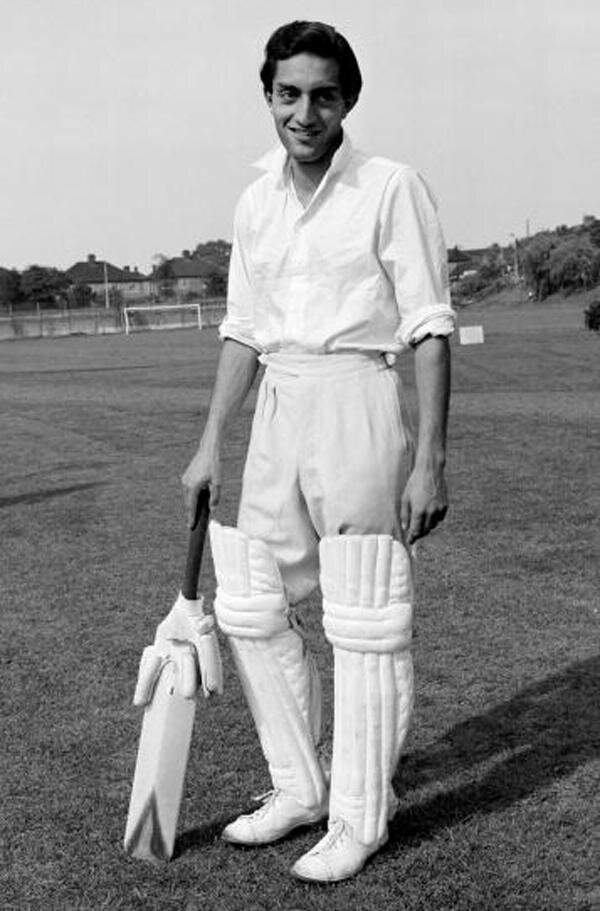
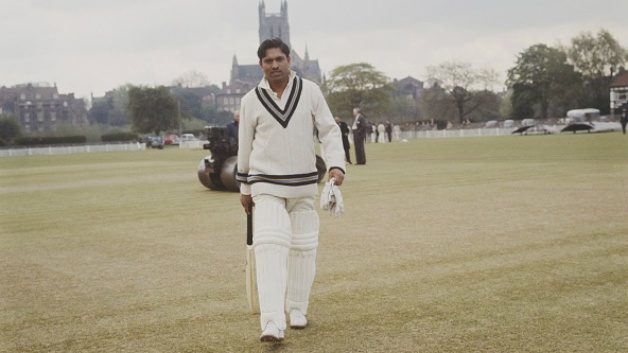
Mansur Ali Khan ‘Tiger’ Pataudi and Chandu Borde played together for almost a decade, through the 1960s. For most of this period, Pataudi also captained India, with Borde, a few years older in age, as his deputy.
Pataudi was made captain mid-way through the series against the West Indies when Nari Contractor was hit on the head by a Charlie Griffith bouncer that almost killed him. He was only 22, and became the youngest man (then) in cricket history to lead his country. Pataudi’s status as a Nawab is believed to have been a strong factor in him being chosen over senior players like Polly Umrigar, Chandu Borde and Dilip Sardesai. But another school of thought argues that Pataudi’s choice was dictated by the need to stamp out parochialism, factionalism and favouritism that had been growing alarmingly in Indian cricket.
Pataudi became one of the most influential figures in Indian cricket, and a heroic figure in the history of sport. A car accident in England when he was barely past 20 robbed him of 95 per cent of vision in one eye. Such a serious handicap would logically make it impossible for anyone to play at the highest level. Pataudi not only did that, but excelled to an astonishing degree. His stats are not overwhelming: less than 3000 runs with six centuries. But till age, and more particularly, worsening eyesight which impacted his reflexes, his record was impressive.
The car accident stymied his development into a batting goliath but Pataudi’s dashing, aggressive approach, brilliant fielding and radical captaincy put Indian cricket on the road to ascendancy. He was a charismatic personality and drew crowds wherever he played.
In 1970, Pataudi was removed from the captaincy by chief selector Vijay Merchant’s casting vote. But he was brought back as captain after India were routed 3-0 by England in 1974 which forced Ajit Wadekar to retire. The India versus West Indies home Test series was fascinating for its massive swings in fortunes, India losing the first two Tests, winning the next two, and losing the decider at Mumbai. Pataudi’s captaincy, and particularly his handling spin bowlers Bedi, Parasanna, Chandrashekhar and Venkataraghavan makes for a textbook case study of cricket strategy.
Chandrakant `Chandu’ Borde was Pataudi’s deputy for the most part, getting to lead the team only in the captain’s absence because of injury or illness. But his contributions to Indian cricket cannot be understated. Like Hazare, Borde too was a Christian. Growing up in Poona, he was drawn to cricket by the exploits of Professor D B Deodhar, the `Grand Old Man’ of Indian cricket, and Kamal Bhandakar, who at one time coached Sunil Gavaskar.
In the initial stages of his career, Borde was a promising all-rounder – a leg spinner, aggressive batsman and electric-heeled in the field. Injury forced him to give up bowling, but this helped develop his batting to a degree that he was touted as India’s best batsman in the 1960s. He had the performances to show for his reputations too. In 1964, he anchored India to a famous win against Australia at the Brabourne Stadium. In 1966 at the same venue, he made a century against the mighty West Indies led by Sir Gary Sobers. Technically sound and with fine temperament, Borde was the most vital player for India in this period along with Pataudi.
Borde’s contribution to Indian cricket did not end with his playing career. He has been administrator, selector, coach at various times since his retirement and was in the selection committee which picked the 1983 World Cup winning team. Borde turned 90 this July. He says he’s looking forward to still helping Indian cricket if needed.
Gavaskar-Vishwanath
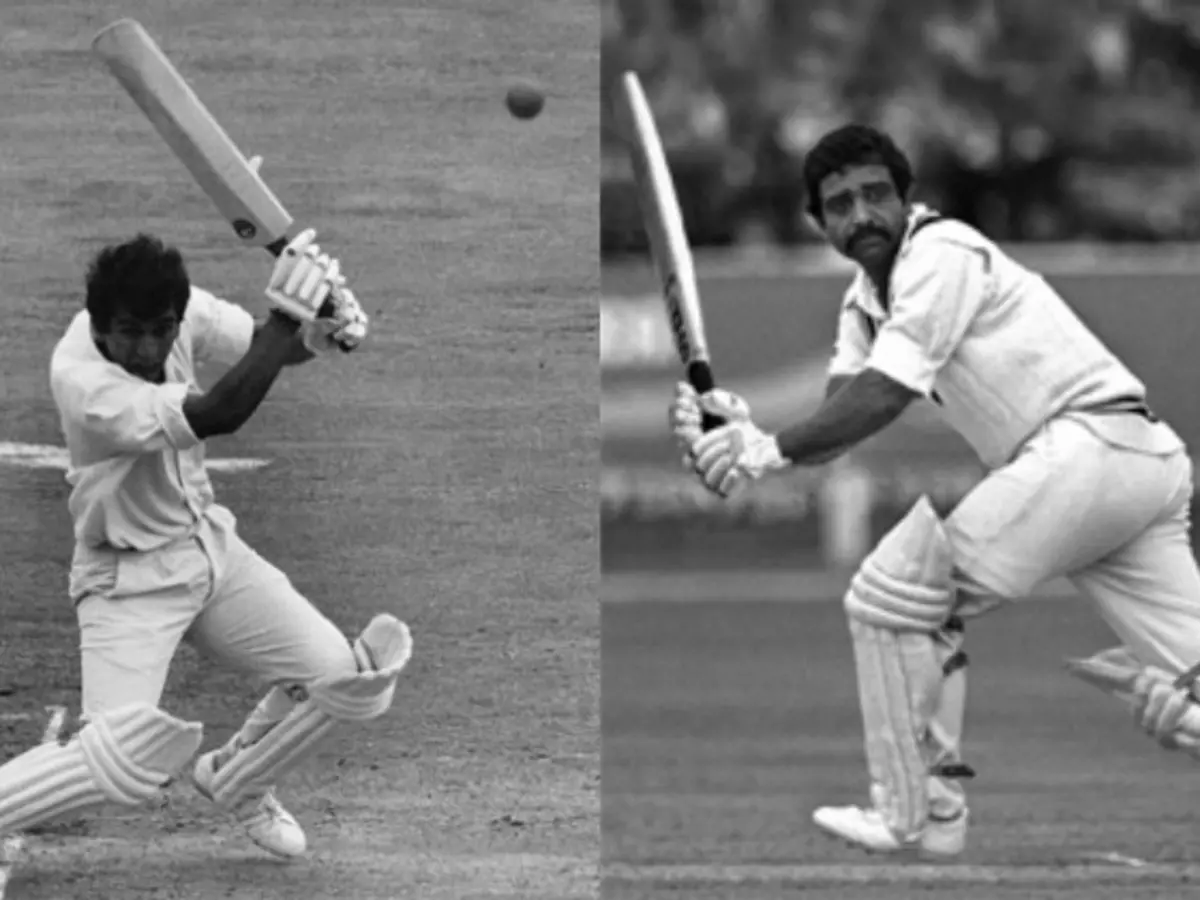
Image courtesy: indiatimes.com
Sunil Gavaskar and Gundappa Vishwanath make perhaps the most fascinating batting duo in Indian cricket. Both born in 1949 (Vishwanath is a few months older), they came into the Indian team on the strength of consistent run-making at the university and first class levels,and once in India colours, propped up India’s batting in contrasting, but brilliant fashion in the 1970s.
Both were part of then chief selector Vijay Merchant’s philosophy of `Catch Em Young’, to infuse fresh lungs, legs and ambition at a time when Indian cricket was beginning to look jaded.
Vishwanath got his India cap first, against Australia in Kanpur in 1969. He made zero in his first innings, but scored a century in the second to herald his arrival as a batting star.
Gavaskar made his debut in the epochal series against West Indies in 1971. He scored a phenomenal 774 runs in the series, a record which has stood the test of time for over half a century. Both were also part of Ajit Wadekar’s team that also beat England a few months later in what is now recalled as the Renaissance of Indian cricket.
The duo dominated the decade with their prolific run-getting all over the world.
Both short statured (at 5’5” Gavaskar was an inch taller), both were technically supreme, but a study in contrast in their approach in the middle. Vishwanath, batting in the middle order, was the more aggressive, wristy and stylish, and brought flair and flourish to the team. Gavaskar, who opened the innings, was the more determined, putting a heavy cost to his wicket, giving Indian cricket spine and steel.
Between them, they raised the bar for batsmanship in Indian cricket to new heights. It remains an irony that while both scored heavily, they did not share too many substantial partnerships. But when they did, as in the record run chase against West Indies in 1976, both making centuries, they created magic.
Along their cricket journey together, they also forged a family bond, Vishwanath marrying Gavaskar’s youngest sister Kavita.
Vishwanath’s ended in 1983. He perhaps made fewer runs and centuries than expected, but he made them in unforgettable style. Moreover, India never lost a Test in which he scored a hundred.
Gavaskar’s career continued till 1987, and he finishes as a Goliath of the game, finishing with the highest run aggregate and most centuries. Between them, these two Little Masters, in their own distinctive way, had become the benchmarks of supreme batsmanship for future generations of Indian cricketers.
Tendulkar-Azhar
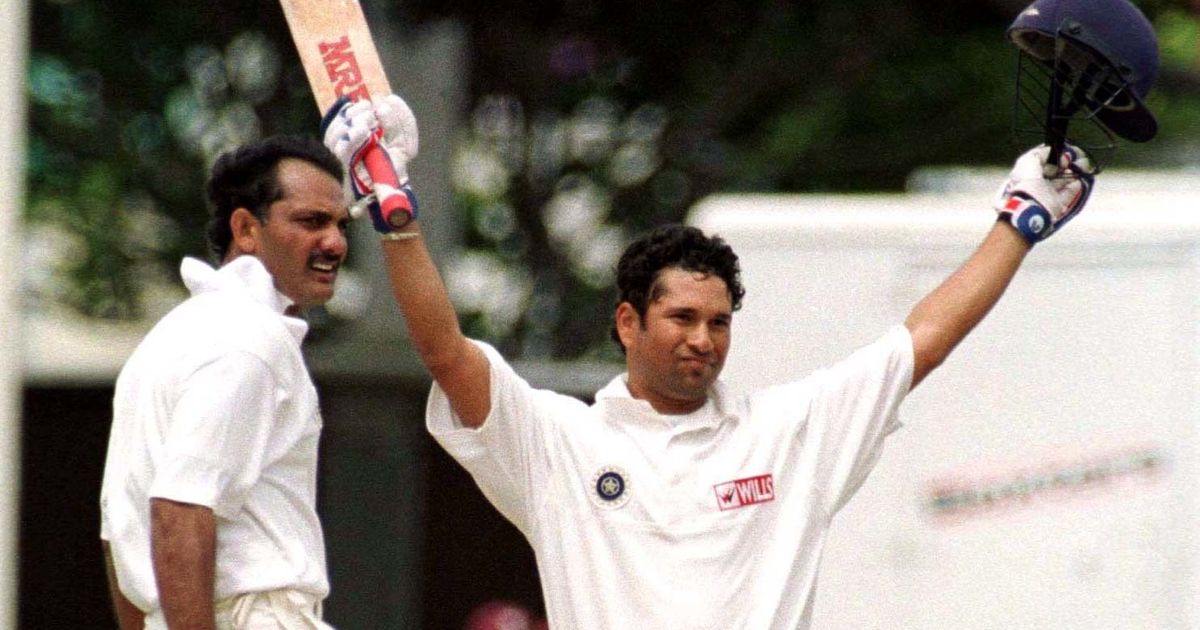
In many ways, Mohamed Azharuddin and Sachin Tendulkar picked up the baton from Vishwanath and Gavaskar. Azharo, tall, willowy was a stylist from Hyderabad whose sweet timing and wristy strokes on both sides of the wicket gave batsmanship, not just in India but the world, a delectable flavour. Tendulkar, who set a world record as a schoolboy, was a prodigy who not only lived up to expectations, but exceeded them in a magnificent career that lasted a whopping 24 years and culminated with most batting records in the game in Tests as well as one-day Internationals.
Azhar began his career with a bang in 1984-85 against David Gower’s England team, scoring centuries in each of his first three Tests. In a career extending to more than 15 years, Azhar won accolades and fans all over the world with his exquisite batting which was always a visual delight. Gavaskar who was his captain in his debut series, and also when India won the World Championship of Cricket in Australia in 1985 where Azhar played a crucial hand, called him `God’s Gift To Indian Cricket’.
Tendulkar, who made his debut as a callow 16-year-old in 1989 against Pakistan under Azhar’s captaincy, was to become talisman of the Indian team, and the most compelling player In the world. His technical virtuosity was akin to Gavaskar’s, but he also had a streak of Viv Richards’s aggressive stroke play in him., making him a colossus. So prolific was his run-making throughout his long career, Tendulkar constantly earned comparisons with Sir Donald Bradman, the Bhishmah Pitamah of batting.
Between them, Azhar and Tendulkar performed outstandingly, individually and together, providing some scintillating partnerships in the 1990s which made India the most popular team in the world.
Azhar’s career sadly ended with allegations against him in the match-fixing scam that erupted in 2000. He had played 99 Tests.
Tendulkar went on to play for 13 years more. Fittingly, he was part of the World Cup winning team of 2011 after 5 futile attempts earlier.
He finished with 200 Tests, the most runs and centuries, and a slew of records in ODI’S too. He had played out such a distinguished career that the sobriquet `God of Cricket’ seemed a perfect fit.
Dravid-Laxman
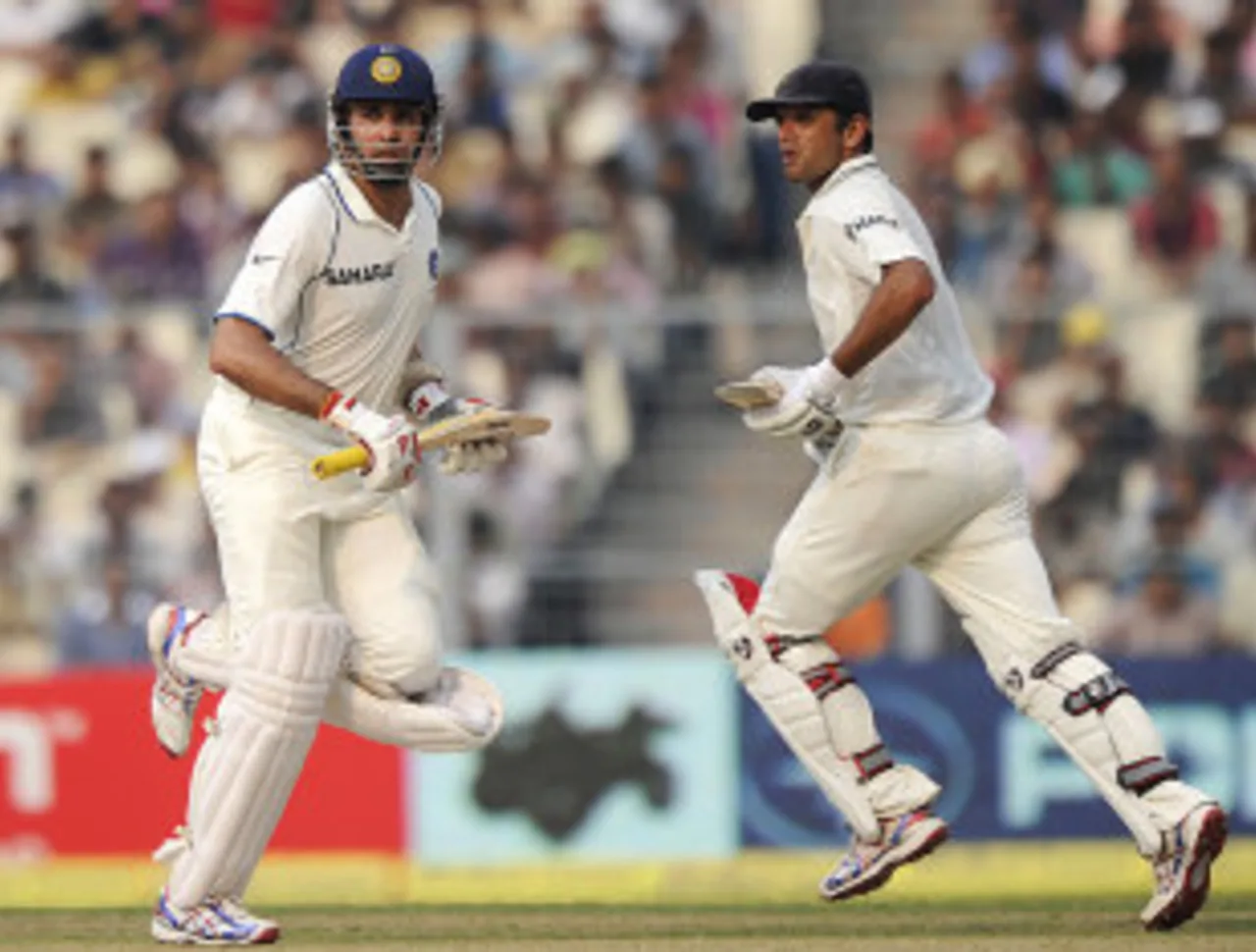
Image courtesy: espncricinfo
Rahul Dravid and VVS Laxman wrote themselves into cricket folklore with their 376 runs-partnership against Australia at the Eden Gardens in circa 2001. India had been bundled out cheaply in the first innings after Australia had scored 445. Following on, the situation looked grim when Laxman and Dravid teamed up. Having lost the first test at Mumbai, India were on the cusp of losing the second Test and the series. What transpired over the next couple of days makes for one of the more astounding stories in cricket.
Laxman and Dravid thwarted the Aussie bowlers heroically, batting out an entire day without being separated. Laxman man-made 281, perhaps the greatest innings in Indian cricket history. Dravid, stoical in support at the other end, made 180. By the time the partnership was broken, India were well into the lead and the pressure was now on Australia to stave off defeat. The Aussies couldn’t. India not only went on to win the Test, but also the series.
The fabulous partnership between Dravid and Laxman was to spark a sense of self-belief in India which saw the team perform superbly against all teams in the ensuing years. India’s overseas record had been woeful. After the Dravid-Laxman jugalbandi at the Eden Gardens, which film-obsessed fans also compared them to the Viru-Jai jodi of blockbuster Sholay, performances overseas saw a surge of excellence.
In 2002, India drew a series in England after losing an early Test. So too in Australia In the same year, India beat Pakistan in Pakistan for the first time. In all these contests, the Dravid-Laxman duo provided sterling partnerships.
Dravid’s consistency and reliability even under extreme pressure earned him the title of `The Wall’. Laxman’s wristy elegance, in the same mould as Vishwanath and Azhar, saw his initials VVS mark him out as Very Very Special. Both descriptions were most apt.



